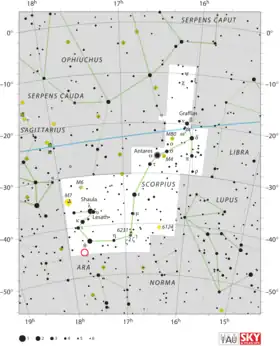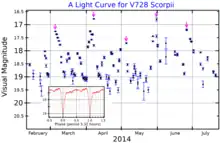 | |
| Observation data Epoch J2000 Equinox J2000 | |
|---|---|
| Constellation | Scorpius |
| Right ascension | 17h 39m 13.239s[1] |
| Declination | −45° 28′ 45.68″[1] |
| Apparent magnitude (V) | 5.0 - 21[2] |
| Characteristics | |
| Variable type | Nova and eclipsing[2] |
| Astrometry | |
| Proper motion (μ) | RA: −9.805[1] mas/yr Dec.: −13.978[1] mas/yr |
| Parallax (π) | 0.4761 ± 0.1257 mas[1] |
| Distance | approx. 7,000 ly (approx. 2,100 pc) |
| Other designations | |
| Database references | |
| SIMBAD | data |
V728 Scorpii, also known as Nova Scorpii 1862, was a nova that occurred in the constellation of Scorpius. It was discovered on 4 October 1862 by John Tebbutt, an astronomer living in New South Wales, Australia, while he was observing a comet. He reported that the star was in the constellation Ara.[4] At the time of its discovery, the nova had an apparent magnitude of 5, making it visible to the unaided eye. Nine days later it had faded to below 11th magnitude, indicating that it was a very fast nova.[5]

Tappert et al. conducted an observing program from 2009 to 2011 to investigate nova candidates. Using photometric and spectroscopic observations, they identified the post-nova star corresponding to Nova Scorpii 1862. On 20 May 2009, the star had a visible-band magnitude of 18.5. They reported that the spectrum resembled that of a dwarf nova with a high orbital inclination, suggesting that it might be an eclipsing variable.[8] Follow-up observations by the same team found that V728 Scorpii was indeed an eclipsing system. All novae are binary stars, in a very close orbit with a "donor" star transferring material to a white dwarf companion. The eclipses in this system appear to be eclipses of the accretion disk surrounding the white dwarf, rather than either star. The orbital period is 3.32 hours.[7]
References
- 1 2 3 4 5 Brown, A. G. A.; et al. (Gaia collaboration) (2021). "Gaia Early Data Release 3: Summary of the contents and survey properties". Astronomy & Astrophysics. 649: A1. arXiv:2012.01533. Bibcode:2021A&A...649A...1G. doi:10.1051/0004-6361/202039657. S2CID 227254300. (Erratum: doi:10.1051/0004-6361/202039657e). Gaia EDR3 record for this source at VizieR.
- 1 2 "V728 Sco". International Variable Star Index. Retrieved 2020-12-31.
- ↑ "V728 Scorpii". SIMBAD. Centre de données astronomiques de Strasbourg. Retrieved 2020-12-11.
- ↑ Tebbutt, J. (March 1878). "On a New Variable in the Constellation Ara". Monthly Notices of the Royal Astronomical Society. 38 (5): 330–331. Bibcode:1878MNRAS..38..330T. doi:10.1093/mnras/38.5.330.
- ↑ Duerbeck, Hilmar W. (March 1987). "A Reference Catalogue and Atlas of Galactic Novae". Space Science Reviews. 45 (1–2): 1–14. Bibcode:1987SSRv...45....1D. doi:10.1007/BF00187826. S2CID 115854775.
- ↑ Vogt, N.; Tappert, C.; Puebla, E. C.; Fuentes-Morales, I. (August 2018). "Life after eruption – VII. A search for stunted outbursts in 13 post-novae". Monthly Notices of the Royal Astronomical Society. 478 (4): 5427–5435. doi:10.1093/mnras/sty1445.
- 1 2 Tappert, C.; Vogt, N.; Schmidtobreick, L.; Ederoclite, A.; Vanderbeke, J. (May 2013). "Life after eruption - II. The eclipsing old nova V728 Scorpii". Monthly Notices of the Royal Astronomical Society. 431 (1): 92–101. arXiv:1302.5570. Bibcode:2013MNRAS.431...92T. doi:10.1093/mnras/stt139.
- ↑ Tappert, C.; Ederoclite, A.; Mennickent, R.E.; Schmidtobreick, L.; Vogt, N. (July 2012). "Life after eruption - I. Spectroscopic observations of 10 nova candidates". Monthly Notices of the Royal Astronomical Society. 423 (3): 2476–2485. arXiv:1204.1501. Bibcode:2012MNRAS.423.2476T. doi:10.1111/j.1365-2966.2012.21054.x.